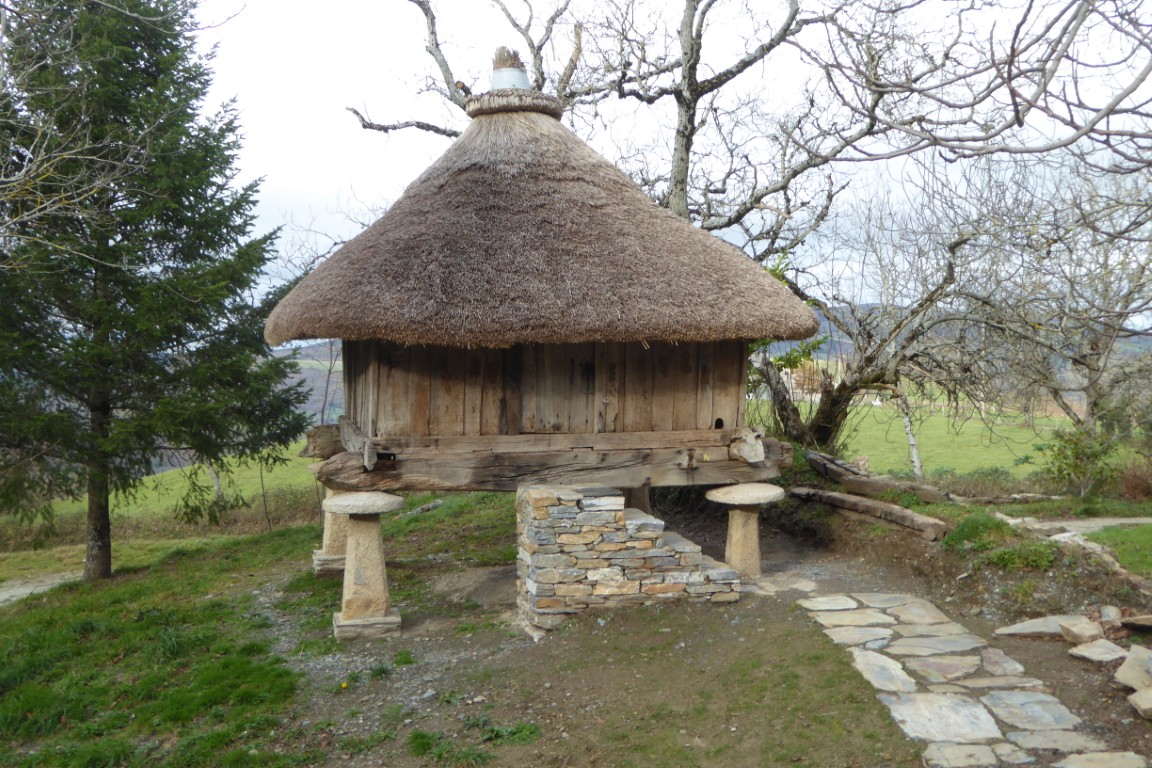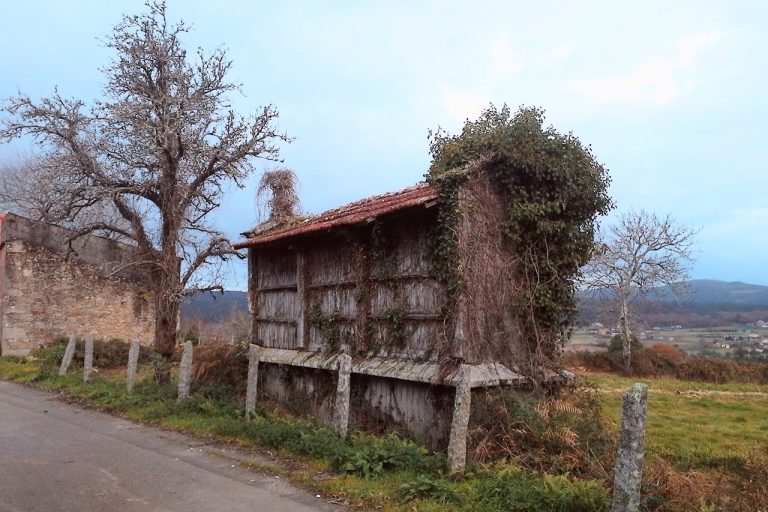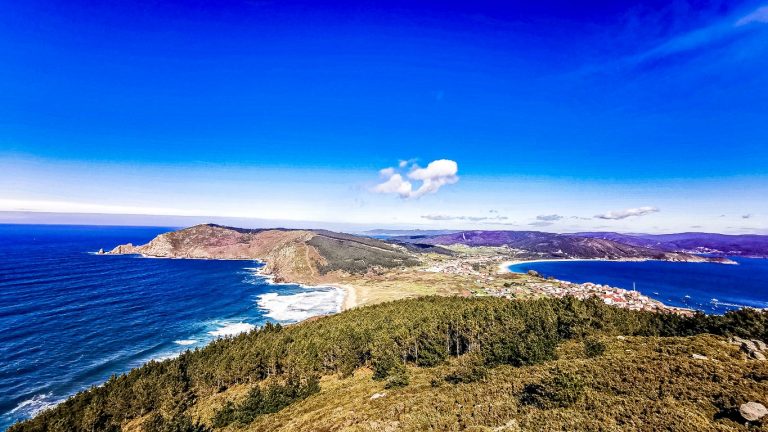
A New Stage – Entry & Atmosphere
The mist of O Cebreiro often still lies like a mysterious veil over the pallozas when you set out on your way. After the great ascent of the previous day, you now feel lighter, your legs finding their rhythm. Yet the heights of the Galician mountains offer no respite: today two passes must be conquered – the Alto de San Roque and the Alto do Poio, the roof of the Camino in Galicia.
What awaits you is a day full of panoramas: the forests of the Ancares, the heights of the Courel, deep valleys, and a constant up and down through ancient mountain villages. On the way to Triacastela and further to Samos you walk alongside history: old pilgrim hospitals, Romanesque churches, and at the end of a long day the venerable Benedictine monastery of Samos – a spiritual center of the Camino since the 6th century.
Route & Elevation Profile
- Distance: 30.8 km
- Elevation: approx. +700 m / –1,100 m
- Difficulty: medium–high
- Character: alpine mountain route, long ascents, steep descents, later transitioning into gentler valleys.













Variants
- Direct variant: O Cebreiro → Triacastela (approx. 21 km), ideal for pilgrims who wish to walk shorter.
- Samos variant: Triacastela → San Cristovo do Real → Samos (+ approx. 9 km), rich in nature and culture, ending at the monastery of Samos.
Description of the Way – Step by Step
From O Cebreiro to San Roque
The path continues to climb immediately after O Cebreiro. Through forests and meadows you reach Liñares (3.2 km) with the church of San Esteban from the 8th century – simple, quiet, yet a place of strength.
Shortly after comes the Alto de San Roque (1,270 m), where the famous bronze statue of the pilgrim stands braving the wind. Here, where the wind often whistles across the heights, you feel the greatness and harshness of the Way – a symbol for all who face the force of nature.
Over the Alto do Poio
After Hospital de la Condesa (6.4 km), with its Romanesque church, the path leads over stony ramps to Padornelo, a place of the Knights Hospitaller who have protected pilgrims here since the Middle Ages. Now comes the hardest climb: in just 300 meters steeply up to the Alto do Poio (1,337 m), the highest point of the Camino in Galicia. From here the views stretch far – back to the Ancares, forward across the Courel mountains.
Descent into the Valley
The Camino now descends:
- Fonfría (10 km): old pilgrim site with a silver chalice from the 17th century.
- O Biduedo (12.4 km): tiny hamlet, smallest church on the Camino (San Pedro). A rest area with tables invites you to pause.
- Fillobal (15.3 km): first village in the valley with albergue and food stop.
- Pasantes & Ramil (17–18 km): Romanesque chapels, manor houses, and an ancient chestnut tree.
Finally you reach Triacastela (19 km) – its name means “three castles,” though only ruins remain. Pilgrims once carried limestone from here to Castañeda, to help build the cathedral of Santiago. The church of Santiago (18th century) with its Romanesque choir is worth seeing.
From Triacastela to Samos
From here the choice: continue directly towards Sarria, or take the variant to Samos – longer, but incomparably rich.
The Samos route leads you through:
- San Cristovo do Real (23 km): village with a Baroque altarpiece, small Roman bridge, and peaceful stillness.
- Renche, Lastres, Freituxe: small hamlets in the Oribio valley, accompanied by forests of chestnut, poplar, and birch.
- San Martiño: Romanesque church from the 12th century, a hidden treasure.
After a steep descent the valley opens – and you see the walls and towers of Samos (30.8 km), one of the oldest monasteries in Europe.
Highlights & Points of Interest
| Place | Distance from O Cebreiro | Highlight |
| Liñares | 3.2 km | Church of San Esteban (8th c.) |
| Alto de San Roque | 5.5 km | Pilgrim statue in the wind |
| Alto do Poio | 9 km | Highest point in Galicia (1,337 m) |
| Fonfría | 10 km | Old pilgrim hospital Santa Catalina |
| O Biduedo | 12.4 km | Smallest church on the Camino |
| Triacastela | 19 km | Church of Santiago, limestone pilgrim tradition |
| San Cristovo | 23 km | Romanesque church, old bridge |
| Samos | 30.8 km | Benedictine monastery (6th c.), spiritual center of the Camino |
Packing & Provision Tips
- Dress warmly: at higher altitudes often windy, even cool in summer.
- Refill water in O Cebreiro, Liñares, and Triacastela.
- Walking sticks are very helpful for the descent to Triacastela.
- For the Samos variant: bring extra provisions, as the villages are small.
Food & Accommodation
- O Cebreiro: large pilgrim albergue (104 beds), small guesthouses.
- Liñares, Hospital, Fonfría: small hostels with mountain atmosphere.
- Triacastela: many albergues and pensions, lively pilgrim town.
- Samos: accommodation in the monastery (donativo), plus several albergues and guesthouses. Especially impressive: a night behind the walls of the Benedictine monastery.
Culinary Notes
Here true Galicia also begins at the table:
- Queso do Cebreiro (D.O.): white fresh cheese, mild and creamy.
- Ternera gallega: tender beef, famous throughout the Camino.
- Cocido gallego: hearty stew with meat, chickpeas, and vegetables.
- Castañas de Os Ancares: roasted chestnuts as pilgrim energy.
- Freixós (Galician crêpes) and leche frita as a sweet reward.
What Makes Today Special
This stage unites the essence of the Galician Camino: windy heights and vast horizons, deep valleys with chestnuts and ancient stone villages, spiritual places and living traditions. At the Alto do Poio you stand on the roof of the Galician Way, a place of strength and sweeping views.
The way to Triacastela recalls how pilgrims for centuries carried stones for the cathedral – an image of the shared work of all who are on the road. And at the end awaits Samos, with its mighty Benedictine monastery, where the voices of monks have echoed for 1,500 years. A place of silence, prayer, and history – and one of the spiritual highlights of the entire Camino.
Reflection at the Stage’s End
In the evening, when you sit on the monastery wall in Samos, hear the sound of the bells, and see the valley in the evening light, you know: today you have arrived deep in Galicia. The Way has shown you how closely nature, history, and spirituality are connected here. And perhaps you feel that your Camino, too, contributes to a great work – stone by stone, step by step.
📊 Tabular Overview
| Stage | Start | Destination | Distance | Elevation | Difficulty | Variant |
| 28 | O Cebreiro | Samos | 30.8 km | +700 m / –1,100 m | Medium–high | Triacastela-direct (21 km) |
🌌 Camino of the Stars:
O Cebreiro → Liñares → San Roque → Hospital → Alto do Poio → Fonfría → O Biduedo → Fillobal → Triacastela → San Cristovo → Samos
Was it the statue at San Roque, the steep ascent to Poio, or the arrival at the venerable monastery of Samos that moved you most? Share your impressions – your Way brings the Camino to life.


